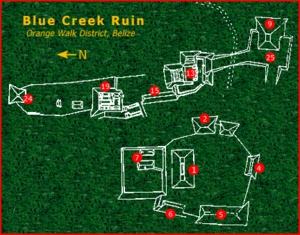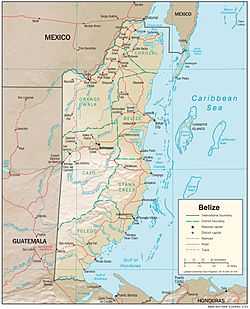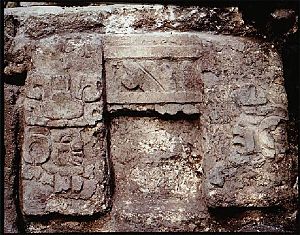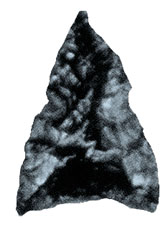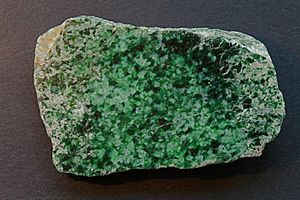Blue Creek (Belize) facts for kids
Blue Creek is a river and an important ancient Maya site in northwestern Belize, Central America. It sits near the border between Belize and Mexico. The river is also known as Rio Azul, which means 'Blue River' in Spanish.
This river flows into a larger one called the Rio Hondo. The special environment around Blue Creek helped the ancient Maya Civilization grow. It was a great place for farming and trade. Many archaeologists have studied this site for years. They have found artifacts showing that Maya communities lived here from around 900 BC to 900 AD.
Contents
Discovering Ancient Blue Creek
Archaeologists first started studying Blue Creek in the 1970s. Before that, not much official research had been done. Since then, many teams of scientists have explored the ruins. They have learned a lot about the Maya civilizations that lived here for over a thousand years.
Data shows that people stopped living at Blue Creek around 800 AD. The site was partly used again about 200 years later. This was at the end of the Classic Maya period. Many ideas explain why the Maya empire declined. Evidence suggests the population dropped, and buildings slowly fell apart.
Some studies suggest that Maya kings' choices about resources might have played a role. For example, how they handled problems like drought or poor soil. Others think that soil problems, in general, led to the society's decline. Today, non-profit groups continue to work at Blue Creek. They help document, protect, and preserve this amazing ancient area.
Blue Creek's Location and Environment
The Blue Creek site is in northwestern Belize, just north of a large cliff called the Bravo Escarpment. It is one of many ancient sites in this area. Blue Creek is part of a "three rivers region." Here, the Rio Azul, Booth’s River, and Rio Bravo all meet. They then form the Rio Hondo.
The site's northern edge is in a deep canyon. The Rio Hondo drops over 100 meters into this canyon. Blue Creek connects the Caribbean Sea to Belize's coast through the Rio Hondo. The area has different types of land. There are limestone uplands and low, wet areas called Bajos. This mix of wet and dry lands shows how diverse the environment is.
Farming in Ancient Blue Creek
Blue Creek has many different types of land and soil. This was very helpful for the Maya people. It allowed them to grow food all year long. The fertile soil above the Bravo Escarpment was especially good. Even modern farmers have had success growing crops there.
Scientists have studied ancient pollen from Blue Creek. This helps them understand what plants grew there in the past. It also tells them about the environment long ago.
Maya Farming Techniques
The Maya used a special farming method called terracing. This technique helped them farm sustainably. Terracing involves building flat steps on hillsides. Its main goal was to stop soil from washing away. It also helped keep the soil moist. This allowed the Maya to use steep slopes that would normally be too hard to farm.
The Maya started using terracing around 250 AD. They did this to deal with soil erosion that happened earlier. They used check dams and natural canals. Later, they developed dry slope terracing. This may have helped Blue Creek grow into a bigger community. Many of these ancient terraces still work today!
The ancient Maya also used their knowledge of the sun and water. They knew how to make the soil fertile. This helped them grow more food. Maya culture also included many rituals in their farming. They made offerings to ensure good rainfall and successful crops.
A special building design called the Quincunx group was used for farming rituals. It had five structures in a square, with one in the middle. People used this design to track the sun's patterns and important solstices. Access to the river was also key for successful farming.
Maya Buildings and Society
Most of Blue Creek’s buildings were along the Bravo Escarpment. The main part of Blue Creek was about 20 square kilometers. This was likely the social center. Historians found two main plaza areas, a ball court, and two courtyards. The Maya planned their buildings carefully. They wanted them to have sacred and cultural meaning.
The layout of Blue Creek helped people communicate. It also provided areas for farming, religious events, and administrative tasks. These activities were deeply connected to their beliefs. Archaeologists have found evidence of four periods of building changes at Blue Creek.
Around 500 AD, a larger group may have taken over Blue Creek. This is suggested by a lack of new construction and the appearance of jade from other areas. Another important part of the site is called the Western Group. Homes of important people, or elites, were usually bigger. They were also located closer to the center of the site and important resources.
Social Classes and Temples
The site has two main sections, called Plaza A and Plaza B. Archaeologists have found over 400 homes at Blue Creek. This shows that there was a clear separation between the rich and common people. For example, Structure 9, known as "The Temple of the Masks," shows this. It suggests that the belief in divine kingship was a big part of Blue Creek's society.
The well-preserved masks on the temple's outside date back to the Early Classic period. These masks show the image of an ajaw, which means 'lord' or 'ruler'. The bibs under the masks also point to their early origins. This building suggests that Blue Creek was an independent community with its own rulers. Another temple, the 'Temple of the Obsidian Warrior', shows more religious practices. Sadly, this temple, like many others, was looted. This has made it harder for archaeologists to study.
Archaeologists also found an unusual building with columns in Plaza A. Most Maya buildings had thick, solid walls. This building had 8 columns instead of walls at the front and back. It was likely a viewing platform for public events.
A special container, called a cache vessel, was found inside a small temple in 1998. This vessel tells us about the Maya's beliefs in cosmology and creation. The Tonina shrine inside Structure 3 has images of mountains and hearthstones. These are thought to be symbols of creation. A limestone boulder found there also suggests it was a valuable resource.
Trade and Resources
Many experts now believe that Maya communities specialized in certain goods. They traded freely with each other. Blue Creek had access to many valuable goods and was a wealthy community. Its success came from its location on the Hondo River. This allowed it to trade with Caribbean coastal communities and other economic centers.
Evidence of river trade includes a dock and dam complex on the Hondo River. These structures were built with cobblestones to help with trade and communication. Deposits from Blue Creek show that trade happened as far south as the Motagua River in Guatemala. These resources were very important. They influenced the social and economic classes within the Maya community. Stone tools from Colha also show that manufacturing was happening. These tools were sent to Blue Creek through trade networks.
Important Resources
The rich soil at Blue Creek was a major resource for farming. Some think that conflicts in the Late Classic period happened because Blue Creek's population grew. At the same time, farming became less productive. This led to competition for soil.
Other valuable resources found at Blue Creek include jadeite and nephrite. These were important sources of wealth. Over 1,500 jade objects were found. Also found were obsidian blades, grinding stones, and sponges from the Caribbean coast. Most of the jade was in important ritual areas.
More than 450 pieces of obsidian were found in one structure alone. These included blades and cores. All of them came from El Chayal, an ancient site in Guatemala known for its obsidian. The Maya used obsidian for tools. Sponges and plant remains from the Caribbean coast were also valued. They were used in religious rituals. These items were often placed in special cache vessels as offerings to the gods. These vessels usually had two ceramic bowls, with precious items like jade, obsidian, shells, and coral inside.
Images for kids
See also
 In Spanish: Río Azul (América Central) para niños
In Spanish: Río Azul (América Central) para niños
- Rio Azul
- Blue Creek, Orange Walk
- List of rivers of Belize


